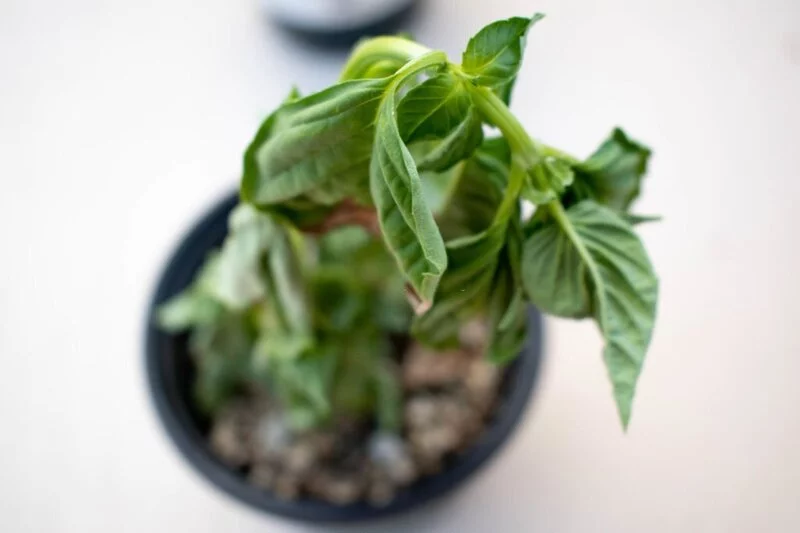If you’re a fan of Italian cuisine or just love the scent of fresh herbs, chances are you’ve tried your hand at growing basil. This aromatic herb is a favorite of many gardeners, but it can be heartbreaking to see it wilt, turn brown, or appear to be on its last legs. So, why is your basil plant dying?
Understanding the potential reasons and how to remedy them is essential to reviving your beloved plant. This article will help you navigate these gardening challenges and ensure your basil plant thrives.
- Package contains 50 organic herb fertilizer spikes and are produced to avoid wasteful runoff, mess, hazards and smells
- Formulated with a 4-3-3 NPK to ensure a continuous supply of nutrients below the surface, where the plants active roots are growing
- Jobe’s organic fertilizer spikes contain no synthetic chemicals and are OMRI listed for organic gardening by the USDA
- Application is simple and should be done at the time of planting or early in the growing season
- Jobe’s fertilizer spikes are pre-measured to provide the right amount of nutrients for herbs without risk of over fertilizing
Ideal Growing Conditions for Basil
Before we dive into the specifics of why your basil might be under the weather, it’s important to understand what basil plants need to grow happily. Here are the basics:
- Sunlight: Basil loves the sun and needs 6-8 hours of daylight every day.
- Soil: Basil requires well-draining soil. Overly damp soil can lead to issues like root rot.
- Watering: Basil does not tolerate drought well. However, it’s important not to overwater either.
- Temperature: Basil is a warm-weather plant. Cold temperatures or frost can harm or even kill the plant.
- Spacing: Ensure your basil plants have enough space to grow. Crowded plants can lead to disease and pest problems.
Understanding these needs is the first step in identifying what might be going wrong with your basil plant. Now, let’s explore the common issues that can lead to a dying basil plant.
Recognizing the Symptoms of a Dying Basil Plant
It’s essential to catch signs of trouble early when it comes to plant care. So, how do you know if your basil plant is dying? Here are some signs to look out for:
- Wilting leaves: This could mean your plant is either not getting enough water, or it’s getting too much.
- Yellowing leaves: This is often a sign of water issues, too. Overwatering or poor drainage can cause leaves to turn yellow.
- Brown spots on leaves: This could be a sign of fungal disease, often triggered by too much moisture and inadequate airflow.
- Stunted growth: If your basil plant isn’t growing as expected, it may not be getting the right nutrients or enough light.
Now, let’s understand what’s causing these symptoms.
Common Reasons Why Basil Plants Die
Understanding the root cause of your basil plant’s struggles is key to bringing it back to health. Here are some common reasons why your basil might be dying:
- Overwatering or underwatering: Both can lead to a struggling basil plant. Overwatering can lead to root rot, while underwatering can cause wilting.
- Poor soil drainage: Basil plants don’t like to have “wet feet”. If the soil stays wet for too long, it can lead to root rot.
- Lack of sunlight: Basil needs plenty of sun. If your plant isn’t getting enough, it may start to fade and wilt.
- Cold temperatures or frost: Basil is very sensitive to cold. Exposure to cold temperatures or frost can seriously damage the plant.
- Disease or pests: Fungal diseases, often resulting from too much moisture, can cause brown spots. Pests like aphids can also harm the plant.
By recognizing these issues early, you can take steps to save your basil plant before it’s too late. Let’s take a look at what you can do to help your plant.
Solutions to Revive Your Dying Basil Plant
Finding your basil plant looking sickly can be quite disheartening. But don’t worry! Here’s what you can do to bring it back to health:
- Adjust watering habits: Make sure the plant is getting just enough water, but not too much. The top inch of soil should dry out between waterings.
- Improve soil drainage: You can add perlite or sand to the soil to improve its drainage capabilities. This prevents water from sitting too long and causing root rot.
- Increase sunlight exposure: If your plant isn’t getting enough sun, consider moving it to a sunnier spot. Basil plants thrive in full sun.
- Protect from cold: If temperatures drop, you might need to bring your basil plant indoors or cover it at night to protect it from the cold.
- Treat diseases and pests: If your plant is infected, it might need a fungicide or pesticide. Look for a natural option if possible, and always follow the instructions on the label.
- 🌳 SUPPORT YOUR INDOOR HERB’S GROWTH – Give your plants the nourishing environment it needs to thrive! This premixed, ready to use soil blend is made up of premium non-organic all-purpose soil.
- 🌳 FIT FOR ALL INDOOR HERB PLANT VARIETIES – Basil, Thyme, Rosemary, Oregano, Mint, Parsley, Sage. Our premium soil won’t disappoint. It maximizes fertilizer absorption and provides excellent aeration to the roots.
- 🌳 PROMOTES OPTIMUM DRAINAGE – Our soil mix holds an adequate amount of moisture to meet the plant’s needs, yet still allows the water to drain well. This helps prevent over-watering.
- 🌳 GET MORE FOR YOUR MONEY – With 2.2 quarts in every bag, our soil offers you great value compared to many other options on the market. It also comes in a sturdy, resealable bag.
- 🌳 BUY WITH CONFIDENCE – Our soil blend is MADE IN THE USA. If you are not satisfied with what you receive, let us know and we’ll arrange a refund or replacement immediately.
Prevention Measures to Keep Basil Plants Healthy
It’s better to prevent issues before they arise. Here are some preventative steps you can take to ensure your basil stays healthy:
- Proper watering: Remember, don’t overwater or underwater your basil plant. Adjust as needed based on the weather and season.
- Good quality soil: Use well-draining soil to avoid waterlogged roots. Regularly add organic compost to keep the soil nutrient-rich.
- Plenty of sunlight: Give your basil a sunny spot to bask in. Most types of basil need at least 6 hours of sunlight each day.
- Regular feeding: Feed your basil with an all-purpose plant food or a homemade compost tea every few weeks during the growing season.
- Regular inspection: Keep an eye on your plant for any early signs of disease or pest infestation. Early detection can make treatment much easier.
With these measures in place, your basil plant will have a better chance of thriving and providing you with a fresh supply of flavorful leaves for your culinary creations!
Frequently Asked Questions about Basil Care
There are a few common questions that come up when people are learning to care for their basil plants. Let’s cover some of the basics:
Why are the leaves on my basil plant turning yellow?
Yellow leaves can indicate a few different problems, including overwatering, underwatering, or a lack of nutrients in the soil.
Can I grow basil indoors?
Absolutely! Basil can be grown indoors as long as it has access to plenty of sunlight and is properly cared for.
How often should I water my basil plant?
This depends on the weather and the moisture level of your soil. As a general rule, water when the top inch of soil is dry to the touch.
How do I get my basil plant to bush out?
To encourage a bushier growth, regularly pinch off the tops of the stems just above where a pair of leaves are growing.
Conclusion
Learning to care for basil plants can be a bit of a learning curve, but once you get the hang of it, you’ll be rewarded with a vibrant, aromatic plant that can add a burst of flavor to your meals. Remember, the key to healthy basil is balance – not too much water, plenty of sunlight, and regular feeding. With a little love and care, your basil plant will thrive and continue to produce delicious leaves for your cooking needs. Happy gardening!





